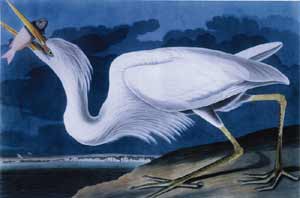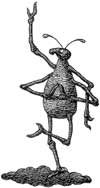Main Menu · Search · Current Issue · Contact · Archives · Centennial · Letters to the Editor · FAQs
 Audubon's great white heron.
Audubon's great white heron. |
A People's History of the Supreme Court, by Peter Irons, J.D. '78 (Viking, $32.95). "This exciting book vividly recounts the dramatic stories behind the Court's landmark cases and memorably portrays the colorful individuals who brought and decided them," writes Nadine Strossen '72, J.D. '75, head of the American Civil Liberties Union. Irons is professor of political science at the University of California, San Diego.
Uncommon Grounds: The History of Coffee and How It Transformed Our World, by Mark Pendergrast '70 (Basic Books, $27.50). The author, who wrote an earlier book about Coca-Cola, may be captivated by caffeine. This is a lively, scholarly, illustrated, 500-page epic.
Mailer: A Biography, by Mary V. Dearborn (Houghton Miin, $30). In his freshman year, writes Dearborn, Norman Mailer '43 was required to take English A, which proved a turning point. It was while reading and rereading Studs Lonigan, U.S.A., and The Grapes of Wrath that Mailer decided to become a writer--and a tough guy. He began to brag of (probably apocryphal) conquests of the local maidens and to tap his cigarette ashes into his upturned trouser cuffs.
Paper Daughter: A Memoir, by M. Elaine Mar '88, M.P.P. '93 (Har-perCollins, $23). At the age of five, the author moved from Hong Kong to Denver and culture shock. She learned English quickly, helped her parents in the kitchen of the Chinese restaurant where they worked, shot the rapids of adolesence, and immigrated to Harvard. Mar was the author of "Blue Collar, Crimson Blazer" (November-December 1995, page 47), and she writes very well.

The Headless Bust: A Melancholy Meditation on the False Millennium, by Edward Gorey '50 (Harcourt Brace, $15). The inhabitants of the Haunted Tea-Cosy--including the Bahhumbug at right--return for this holiday season.
Mapping Boston, edited by Alex Krieger, M.C.U. '77, chairman of the department of urban planning and design, and David A. Cobb, head of the Harvard Map Collection, with Amy Turner (MIT Press, $50). Eleven contributors explore the intertwining of maps and history and in the process chronicle Boston's development in a creative way, greatly aided by many maps, of course, and paintings, prints, and charming old photographs.
Nobody's Children: Abuse and Neglect, Foster Drift, and the Adoption Alternative, by Elizabeth Bartholet '62, LL.B. '65, Wasserstein public interest professor of law (Beacon Press, $27). Bartholet scrutinizes child-welfare policies on abuse and neglect and on foster care. She wonders why family-preservation ideology still prevails, and she urges everyone to take the adoption option seriously.
Salts of Silver, Toned with Gold: The Harrison D. Horblit Collection of Early Photography, by Anne Anninger, Ph.D. '94, Hofer curator of printing and graphic arts, and Julie Mellby, assistant curator (Houghton Library, distributed by University of Washington Press, $25, paper). This catalog of an exhibition last spring at Houghton Library contains 65 duotone reproductions of images, with learned commentary, highlighting a vast, rich collection of nineteenth-century photographs recently given to the library.
No Twilight About Me: A Life in Letters, edited by Lansing Lamont '52 (privately published; available for $35 from the Madison Avenue Bookshop, 800-535-4912). Here's an American success story, reflected in the letters of two remarkable people to their children. Thomas W. Lamont, A.B. 1892, for whom Lamont Library was named, was a banking titan of supreme diplomatic skills. His wife, Florence, created one of New York's brightest lit-erary salons. Grandson Lansing, a former Time correspondent, writes that they "and a handful of their peers were the closest thing in America to royalty." Their four children were Thomas '21, the "fiercely unconventional" Corliss '24, Austin '27, and Eleanor, who broke ranks and went to Smith.